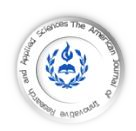
GENERAL INFORMATION

| ISSN: 2429-5396 (e) | www.american-jiras.com | |
| Web Site Form: v 0.1.05 | JF 22 Cours, Wellington le Clairval, Lillebonne | France |
| Web Site Form: v 0.1.05 | JF 22 Cours, Wellington le Clairval, Lillebonne | France |

ResearchBib, Google Scholar, SIS database, i.f.s.i.j, Scribd, IISJ, Eurasian Scientific Journal Index (ESJI), Indianscience.in, arastirmax, Directory of Research Journals Indexing, Pak Academic Sesearch, AcademicKeays, CiteSeerX, UDL Library, CAS Abstracts, J-Gate, WorldCat, Scirus, IET Inspec Direct, and getCited
Indexed by:
| HOME | ABOUT US | ARCHIVE | AIMS AND SCOP | AUTHORS | REVIEW | SUMIBMIT MANUSCRIPT | EDITORIAL BOARED | PUBLICATION FEE |
| | ARTICLES | Am. J. innov. res. appl. sci. Volume 10, Issue 4, Pages 165-171 (April 2020) |
| Revew Article 2 |


|
American Journal of innovative
Research & Applied Sciences
Research & Applied Sciences
ISSN 2429-5396 (Online)
OCLC Number: 920041286
OCLC Number: 920041286
| HOME || ABOUT US || ARCHIVES || AIMS AND SCOP || AUTHORS || REVIEW|| SUBMIT MANUSCRIPT || EDITORIAL BOARD || CONTACT US |

| APRIL | VOLUME 10 | N° 4 | 2020 |

| Info-AJIRAS-® Journal ISSN 2429-5396 (Online) / Reference CIF/15/0289M |
American Journal of Innovative Research & Applied Sciences
*Corresponding author Author & Copyright Author © 2020: | Zoarilala Rinah Razafindrakoto |. All Rights Reserved. All articles published in American Journal of Innovative Research and Applied Sciences are the property of
Atlantic Center Research Sciences, and is protected by copyright laws CC-BY. See: http://creativecommons.org/licenses/by-nc/4.0/
Authors Contact
*Correspondant author and authors Copyright © 2020:
|Zoarilala Rinah Razafindrakoto 1* |Nantenaina Tombozara 1,2 |David Ramanitrahasimbola 1,3 | Dina Fitia Raoelihajaina 3 |
and | Dina Andriamahavola Rakotondramanana 3 |
Affiliation.
1. Institut Malgache de Recherches Appliquées | Laboratoire de Pharmacognosie Appliquée | Itaosy | Madagascar |
2. University of Antananarivo| Faculty of Sciences, Organic Chemistry Department | Laboratory of Applied Chemistry to Natural Substances |
Antananarivo | Madagascar
3. University of Antananarivo | Faculty of Medicine, Pharmacy Department | Antananarivo | Madagascar |
This article is made freely available as part of this journal's Open Access: ID | Zoarilala-Ref.1-ajira310320 |
ABSTRACT
Background: Ageratum conyzoides (ASTERACEAE) is traditionally used against asthma, articular rheumatism and arterial high blood pressure in Malagasy folk medicine. Few studies are conducted on its antihypertensive activity. Objectives: This study aims to validate the use of this plant as antihypertensive through the vaso-relaxing property of the aerial part methanol extract (ME) and the action mechanism of ethyl acetate fraction (EF). Methods: Dried powder of A. conyzoides aerial part was extracted by maceration in methanol. Methanolic solution was depigmented by activated charcoal then filtered on Whatman’s filter paper and evaporated to dryness. This methanol extract was dissolved in distilled water and then successively partitioned with hexane, dichloromethane, ethyl acetate and butanol. The vaso-relaxing activity of extract and fractions was assessed on the phenylephrine pre-contracted isolated rat aorta. Action mechanism of ethyl acetate fraction (EF) was determined using three active reagents including propranolol, indomethacin and L-NAME. Phytochemical screening was assessed in ME with common methods as well as acute toxicity in mice. Results: Phytochemical screening shows the presence of phenolic compounds, flavonoids, tannins, saponins, steroids, quinones and anthraquiniones. Tested on isolated rat aorta, ME exhibits a moderate activity (EC50 = 383.44±17.34 μg/ml). After bio-guided fractionation, EF, with EC50 of 204.07±8.50 μg/ml, was the most active. This activity wasn’t modified by propranolol and indomethacin but with L-NAME, the EC50 was increased to 584.04±30.98 μg/ml and the tested maximal concentration does not allow achieving its maximum effect. The acute toxicity tests showed that ME is devoid of toxicity. Conclusion: The anti-hypertensive activity of A. conyzoides is partly the result of the vaso-relaxing effect of bioactive molecules dissolved in ethyl acetate. These results contribute to explain the antihypertensive virtue of Ageratum conyzoides.
Key words: Ageratum conyzoides, antihypertensive activity, vaso-relaxing activity
Background: Ageratum conyzoides (ASTERACEAE) is traditionally used against asthma, articular rheumatism and arterial high blood pressure in Malagasy folk medicine. Few studies are conducted on its antihypertensive activity. Objectives: This study aims to validate the use of this plant as antihypertensive through the vaso-relaxing property of the aerial part methanol extract (ME) and the action mechanism of ethyl acetate fraction (EF). Methods: Dried powder of A. conyzoides aerial part was extracted by maceration in methanol. Methanolic solution was depigmented by activated charcoal then filtered on Whatman’s filter paper and evaporated to dryness. This methanol extract was dissolved in distilled water and then successively partitioned with hexane, dichloromethane, ethyl acetate and butanol. The vaso-relaxing activity of extract and fractions was assessed on the phenylephrine pre-contracted isolated rat aorta. Action mechanism of ethyl acetate fraction (EF) was determined using three active reagents including propranolol, indomethacin and L-NAME. Phytochemical screening was assessed in ME with common methods as well as acute toxicity in mice. Results: Phytochemical screening shows the presence of phenolic compounds, flavonoids, tannins, saponins, steroids, quinones and anthraquiniones. Tested on isolated rat aorta, ME exhibits a moderate activity (EC50 = 383.44±17.34 μg/ml). After bio-guided fractionation, EF, with EC50 of 204.07±8.50 μg/ml, was the most active. This activity wasn’t modified by propranolol and indomethacin but with L-NAME, the EC50 was increased to 584.04±30.98 μg/ml and the tested maximal concentration does not allow achieving its maximum effect. The acute toxicity tests showed that ME is devoid of toxicity. Conclusion: The anti-hypertensive activity of A. conyzoides is partly the result of the vaso-relaxing effect of bioactive molecules dissolved in ethyl acetate. These results contribute to explain the antihypertensive virtue of Ageratum conyzoides.
Key words: Ageratum conyzoides, antihypertensive activity, vaso-relaxing activity
VASO-RELAXING ACTIVITY OF Ageratum Conyzoides Linn. (ASTERACEAE) AERIAL PARTS ON ISOLATED RAT AORTA
| Zoarilala Rinah Razafindrakoto 1* | Nantenaina Tombozara 1,2 | David Ramanitrahasimbola 1,3 | Dina Fitia Raoelihajaina 3 | and | Dina Andriamahavola Rakotondramanana 3 |. Am. J. innov. res. appl. sci. 2020; 10(4):165-171.
| PDF FULL TEXT | | XML FILE | | Received | March 27, 2020 | | Accepted | April 13, 2020 | | Published | April 24, 2020 |
| Zoarilala Rinah Razafindrakoto 1* | Nantenaina Tombozara 1,2 | David Ramanitrahasimbola 1,3 | Dina Fitia Raoelihajaina 3 | and | Dina Andriamahavola Rakotondramanana 3 |. Am. J. innov. res. appl. sci. 2020; 10(4):165-171.
| PDF FULL TEXT | | XML FILE | | Received | March 27, 2020 | | Accepted | April 13, 2020 | | Published | April 24, 2020 |